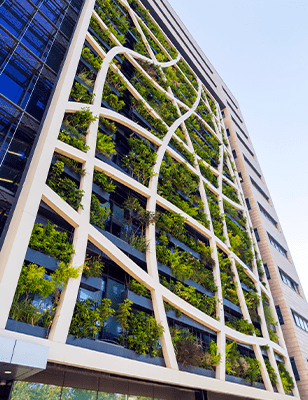At Arcadis, we are in the business of sustainability. We have committed to halving total company emissions by 2028 and we are walking the talk. In June last year, in the midst of the pandemic, we moved our London HQ to 80 Fenchurch Street, a building with a BREEAM “Excellent” rating. At 80Fen, we are able to mitigate our environmental impact by reducing carbon consumption as well as lowering our costs – with an expected 75% decrease in energy needed for heating and ventilation.
We are not alone in asking more and greener from our workplace. Demand for property with strong green credentials is growing at pace, driven by occupiers, investors and lenders alike. Unsurprisingly, this is driving a value differential in favour of green buildings. Both the rents that tenants are prepared to pay and occupancy rates are pushed upwards, lifting up the value of developments.
Evidence abounds. Detailed research by Knight Frank into rent premia in the London office market shows a marked stepped-in increase across BREEAM top ratings to 12.3% for “Outstanding”. And a Cushman & Wakefield report indicated that LEED-certified assets in the US held a 21.4% market sales price premium over non-LEED buildings. In Australia, a 5 star NABERS Energy rating is estimated to deliver a 9% green premium in value.
On the flip side, the assets that fail to deliver on sustainability risk being less attractive to tenants and lenders and could prematurely devalue and become stranded. A recent survey by Deepki of institutional real estate investors and property professionals in the UK found that 66% have already seen a decrease in both the capital and rental value of their portfolios due to poor sustainability performance.
You will need to focus on the sustainable design and operational performance of existing assets if you are:
- looking to acquire assets and increase the long-term value of your portfolio. You will be able to benefit from greater transparency – e.g., with the planned launch of performance-based rating system for landlords in the UK, as well as access to cheaper funding.
- holding assets and wanting to preserve value over time. Upgrading your assets to reduce your carbon footprint – e.g., planning for you portfolio to be EPC B can enable you to attract new and higher-end tenants as well as enhance your company’s ‘purpose’ – to quote BlackRock CEO Larry Fink in his letter to CEOs on 17 January.
- selling assets and want to show carbon performance to buyer. You will be able to make use of ratings and disclosures – under new requirements such as Sustainable Finance Disclosure Requirements, Task Force for Climate related Financial Disclosures increase the visibility and competitiveness of assets to potential buyers.
Taking the appropriate action is complex and requires data intelligence and expertise. At Arcadis, we have been helping clients in the office, retail and industrial sectors assess and lower their energy use and carbon footprint. If you are looking to future-proof your assets and minimise the risk of ‘carbon stranding’, here are some bits of wisdom we’d like to share:
- Operational carbon is still the name of the game. Use EPC as a blunt tool for a first screening, but focus on whole building energy consumption, including from tenants’ plug-load, to assess whether the building is competitive. You can also expect embodied carbon to become more of a value driver in the near future. We are seeing deals turned down or prices chipped on the basis of carbon performance.
- Effective tenant relationship is key. Consider the effectiveness of green leases with existing tenants and how well the building is being run. Your ability to collaborate with tenants in the future could be a sustainability risk. We have seen how poor terms and uncooperating parties can increase the risk of stranding.
- Think ‘social’ and ‘governance’ and not just ‘environmental’. Landlords have a joint responsibility with tenants. How does the asset align with our social values? An increasing focus on the ‘G’ in ESG – to encompass corporate sustainability, and ‘S’ – covering occupant health and employees’ wellbeing, is also becoming a factor in asset price negotiations.
Are you ready to grab the opportunities and protect your real estate portfolio from carbon stranding risks?





